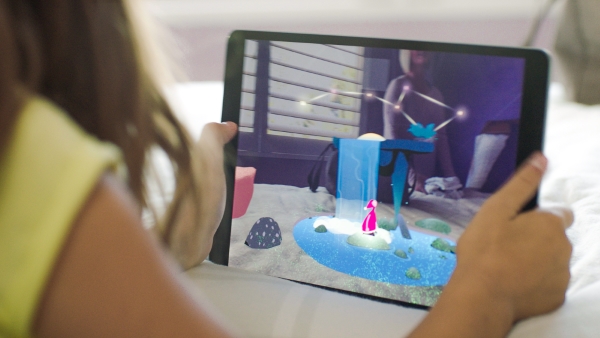[This story from Variety describes a promising augmented reality app that lets students experience and interact with stories, and goes on to explore the status, challenges and potential of mobile-based AR. See the original version for four additional images. –Matthew]

A Sense of Wonder: How Within Is Evolving Storytelling in Augmented Reality
By Janko Roettgers
November 6, 2018
The future of storytelling is happening all around us — we just have to look through the right lens to see it. That’s the idea behind “Wonderscope,” an augmented reality app for children that Los Angeles-based immersive media start-up Within is set to release in November.
“Wonderscope” uses mobile AR to superimpose characters, scenes and stories onto an iPad’s camera view of a user’s living room carpet or a kid’s bedspread. “A device that everyone carries around in their pocket every day suddenly has this new magical ability,” explains Within CEO Chris Milk. “It’s like a lens for invisible magical things that you couldn’t see with your naked eye.”
One of the first stories to be released as part of “Wonderscope” is titled “Little Red the Inventor,” a modern twist on the classic fairy tale “Little Red Riding Hood.” Not only is Red in Within’s version devoted to science and engineering, but she’s also facing off against a wolf that Milk describes as a #MeToo-like villain. In the end, Red persists with the help of her friend, the viewer, who communicates with her via speech-recognition technology.
AR-based stories can be a significant change from other screen-based media, argues Within CTO Aaron Koblin. “Parents love the idea that their kids aren’t sitting there vegged out,” he says. “They’re actually engaged and moving around, they’re reading out loud. It’s a way more active experience, which we’re really excited about.”
For Milk, this also made the project deeply personal. “In some ways, I’m making the product that I wish I had when I was 7,” he recalls. “7-year-old me was a dyslexic kid that had a lot of trouble reading. I would really have loved to have something like this in my life, where I was active in a conversation with a character.”
Within is just the latest start-up to embrace mobile-based AR, which Apple first introduced with the release of its iOS 11 mobile operating system about a year ago. Google followed suit with its own take on the technology for Android-based phones a few months later. Together, the two companies now have hundreds of millions of mobile devices that are AR-enabled.
The future of AR is already lurking around the corner: Two months ago, Florida-based hardware startup Magic Leap began to ship a developer version of its AR headset, which combines a view of the real world with digital objects. Apple and other tech companies are said to have their own AR glasses in the works as well.
But while mobile AR has been available for a little over a year, it’s taken some time for creatives to explore the full potential of the medium. An initial slate of apps largely offered up short-lived gimmicks that didn’t satisfy consumers.
Downloads of AR iOS apps spiked in December 2017, and have since leveled off, according to mobile analytics specialist App Annie. In July 2018, users downloaded some 1.25 million copies of the top 500 AR iPhone apps. “To put that in context, there were over 500 million iPhone downloads in the U.S. alone during that month,” says App Annie senior market insights analyst Lexi Sydow.
Milk, who previously directed music videos for artists like U2 and Kanye West, isn’t worried about those trends. “It always takes a while to figure it out,” he says. “In the beginning of cinema, you’d put a penny into a machine to watch a dancing bear for 15 seconds. The first stabs at a medium feel more like novelties than complete stories.”
Part of the challenge for creatives is to figure out how to tell compelling tales in this new medium without leaving the viewer overwhelmed, says Magic Leap chief content officer Rio Caraeff. “Sparse digital content is better than lots of digital content,” he advises. “If the entire physical world is overwhelmed with digital stuff, that can overwhelm my cognitive load.”
Magic Leap interaction director Aleissia Laidacker echoes this notion: “We are always saying: less is more.” At the same time, she readily admits that creating content for AR is still very much an unknown territory. “We actually don’t know all the best practices yet.”
One of the problems of AR content creation: Developers don’t know in which contexts and environments viewers will use their apps. “You have to build a story that can work in someone’s kitchen, in someone’s backyard, next to someone’s pool,” says Milk. Caraeff agrees: “As a developer, you don’t control what anybody’s home looks like. So you have to embrace ambiguity and uncertainty.”
The same could be said for developing immersive media apps in general. A little over two years ago, start-ups and studios alike jumped headfirst into virtual reality as the future of storytelling. With headset sales lagging, some have since reversed course.
Disney-backed Jaunt, which at one time aimed to be the leader in cinematic VR, announced two weeks ago that it was laying off its entire VR staff to focus solely on AR. Imax closed some of its VR Centers and is reevaluating its commitment to the space, and Google is also said to be prioritizing AR over VR.
Does this make AR the next VR? “We don’t think that this is a one-versus-the-other type situation,” says Within chief operating officer Colin Decker, who previously worked as GM for Discovery Digital and COO of Crunchyroll. “VR disappointed anyone who had an irrational view of what it was going to be in an irrationally short time,” he says. “We think that both AR and VR hold great promise and great potential.”